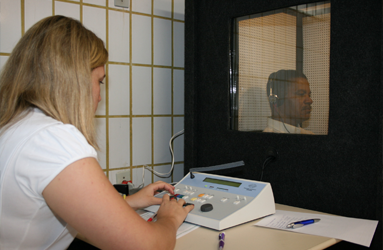National Center for Rehabilitative Auditory Research (NCRAR)
Ototoxicity Monitoring Tests
 What tests are done during an ototoxicity monitoring audiology exam?
What tests are done during an ototoxicity monitoring audiology exam?Ototoxic drug therapies are used as life-preserving health care in a number of different patient populations and clinical settings ( e.g., medical oncology, pulmonology, otology, cystic fibrosis and infectious disease). There may not be one exclusive test battery that works for every clinic, population or patient; however, the recommended tests, per ASHA & AAA, include patient questionnaires for subjective measures, otoscopy, immittance, and all bilateral pure tone air conduction thresholds from 250 Hz to 8 kHz. This is followed by speech recognition thresholds and bone-conduction testing. Tinnitus occurrence or changes, which can be an early indicator of ototoxicity, can be measured with screening questionnaires and patient-report. High frequency air conduction testing (above 8kHz), including the sensitive range for ototoxicity (SRO), is highly recommended for early detection of initial hearing changes. Finally, otoacoustic emissions (OAEs) are utilized for an objective ototoxicity measure should the patient become too ill to provide a reliable hearing test. The ASHA and AAA guidelines state that conducting all of these tests at each test visit may not be feasible, and suggest ways to shorten the protocols.
What is vestibular toxicity and what tests are done?
Vestibular ototoxicity relates to the damage of the vestibular nerve and the balance structures within the inner ear that connects to the brain caused by ototoxic medications. The damage itself is caused by the penetration of such ototoxic drugs, leading to rapid uptake and long exposure times to the inner ear tissues. Vestibular ototoxicity progresses slowly so it can go unnoticed, however when present patients may experience symptoms such as vertigo, oscillopsia, disequilibrium, unsteadiness or dizziness. Monitoring for vestibular toxicity includes vestibular autorotation test (VAT), vestibulo-ocular reflex testing equipment (VORTEQ), electronystagmography (ENG), computerized dynamic posturography (CDP), rotary chair testing, and video nystagmography (VNG). Similar to auditory testing, monitoring for vestibular function and tinnitus may need to be conducted as a screening test to be feasible.
- Vestibulotoxicity: Strategies for clinical diagnosis and rehabilitation (Link to external reference by Dr. Handelsman)
- Vestibulotoxicity Primer



















